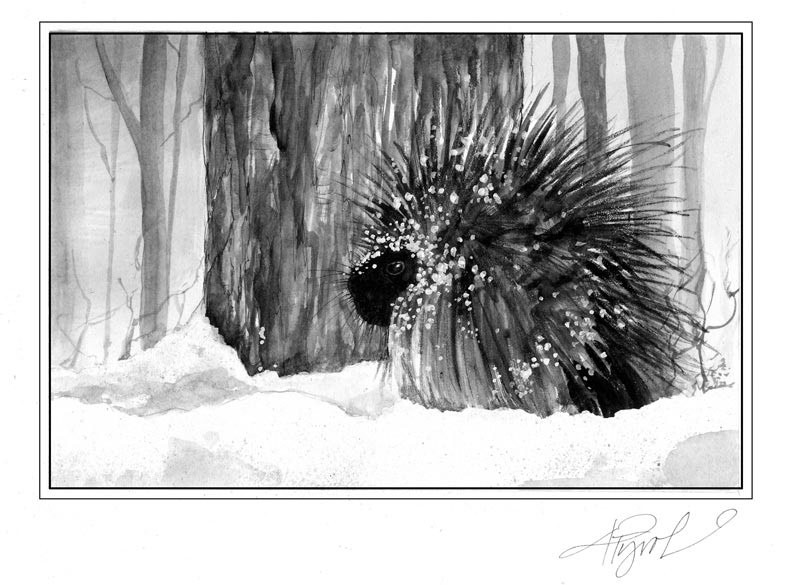
Last winter while walking in snow near my home in Worcester, Vt., I encountered a set of unusual paw prints by a creek. Curious, I followed the trail, my head bowed toward the ground, until the tracks disappeared into scrub. Leaning against a hemlock, I peered into the brush, and seeing nothing, I turned and almost tripped over a big fat porcupine, bunched up in a near ball in a snow-blown spot against the tree trunk.
It shrank as close to the tree as possible, quills rising and then flattening as it breathed. My tracking skills were laughable: They led me to nearly fall on one of the Northern Forest’s more dangerous wild creatures – dangerous, that is, if you happen to be a dog.
A few weeks later, in spring, on a walk with my young terrier, we encountered a porcupine carcass on a wooded trail, and, like any self-respecting dog, he gave the kill a close inspection. Too close. Later in the evening, in the bathroom, with large tweezers and an Internet printout on quill removal, I used newly found doctoring skills to help my pup.
Porcupines are tempting to any dog, and the dog usually gets the worst of it. A while ago, a friend of mine had to euthanize her pet after the animal was pierced by 300-plus quills in his face alone. It had been the dog’s sixth porcupine confrontation.
Porcupines create trouble for more than just a few unlucky dog owners. They are considered pests by many a woodlot owner. In winter they eat bark, sometimes girdling and killing trees. In their search for salt, they sometimes go to extremes. A trapper I knew out West was once stranded 50 miles from civilization after his truck was immobilized thanks to the porcupine that had chewed on the vehicle’s wiring that had been coated in road salt.
In search of salt, porcupines will gnaw on just about anything—tool handles, sweaty clothing, leather boots, the dirt on salted winter roads. In their natural habitat they eat sodium rich plants, like the yellow water lily, and will gnaw on animal bones and shed antlers; but when they come up short, they will look for other sources to keep their blood chemistry in balance.
A century ago New Hampshire and Vermont placed bounties on porcupines to help protect valuable forestland. The bounties were in effect until the 1950s, when the two states adopted another strategy: They took steps to boost populations of the porcupine’s natural predator, the fisher. Vermont went so far as to ‘reintroduce’ to the state fishers that had been live-trapped in Maine.
Fishers, the size of large house cats, are members of the weasel family. Once valued for their thick and silken fur, they were nearly eliminated in our region in the 19th century due to unrestrained trapping and loss of habitat as woodlands gave way to farmlands.
Currently, fisher populations are flourishing throughout much of the region, and the animals are now being blamed, rightly or wrongly, for chicken killings and cat-snatchings.
Fishers are skilled hunters and they travel far for their meals. One New Hampshire study calculated a mean home-range size of 11 square miles for males and 6 square miles for females. While their diet varies widely depending on available prey, they will kill porcupines. They will do so by repeatedly attacking its face, while moving to avoid contact with quills. The porcupine will eventually succumb to blood loss and shock, at which time the fisher will flip the porcupine over and feed on its quill-less belly.
The porcupine I encountered up close last winter had nothing to fear from me, and apparently began to realize that after a few minutes. Its breathing slowed, and it turned to look at me. We stared at each other for a few more minutes, and then I whispered “thank-you” and stepped away.
Later, from the warmth of my house I watched snow start to fall again and wondered whether a fisher might be curled up in tree nearby, waiting to hunt my porcupine. I didn’t want my dog subjected to another fight with the porcupine’s quills, but I also wasn’t happy with the thought of that porcupine with the doleful eyes being ripped apart for dinner.


Discussion *